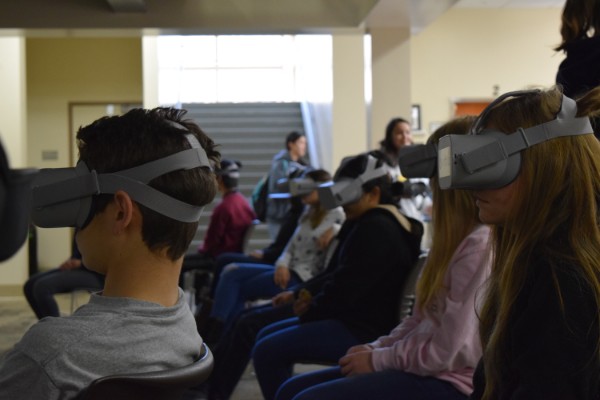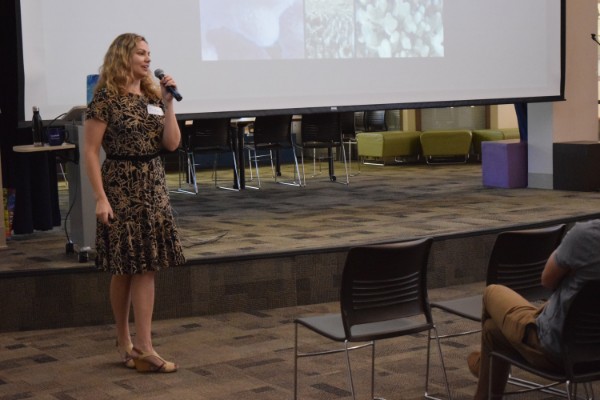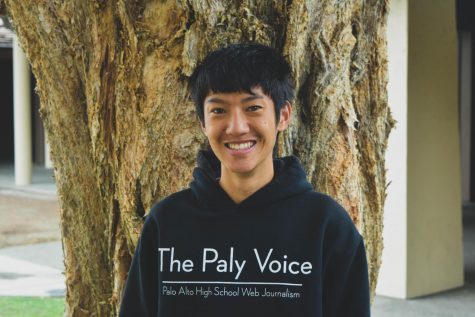Virtual reality brings the ocean to Paly
February 25, 2019

For a group of 30 Palo Alto High School students, what would have been an everyday Tutorial period transformed into an immersive virtual reality experience on Friday in the Media Arts Center.
Paly’s ClimateVision Club hosted marine biologist Erika Woolsey, who provided VR headsets and a film, called IMMERSE, which simulates a short underwater in a coral reef, complete with a descent and ascent.
“It’s structured like a dive profile, where you immerse in the beginning, you descend, you have a bottom time where you can explore and learn, and then there’s an ascent at the end where you learn about all the great things that are being done,” Woolsey said.
After Woolsey gave a short presentation on coral reefs and the factors that endanger them, some students left the MAC, while others eagerly lined up to use the 12 VR headsets available.
“It was a little blurry, but other than that, it was definitely really cool to be able to see what goes on during those dives,” junior Miles Breen said. “I knew there had been problems with the environment and coral bleaching but I never knew to what extent it could be, so when she [Woolsey] mentioned a figure about 99.9 percent of coral being dead at the end of the century it was really shocking.”
Woolsey is the CEO of The Hydrous, a nonprofit company focusing on educating the public on issues relating to the ocean. She said that IMMERSE is more effective at conveying information than more conventional methods of teaching.
“There’s a lot of interesting research suggesting that these immersive experiences through VR and 360 compared to a lecture or a two-dimensional movie can generate more empathy and more interaction,” Woolsey said. “My hope is that using this medium can sort of teleport people to places they haven’t been before.”
ClimateVision Club member and senior Galileo Defendi-Cho said that deciding to host Woolsey’s presentation was a relatively unusual endeavour.
“Our main goal is to reduce climate change by reducing carbon emissions, so this [the presentation] is a little bit out of character for our club in relation to oceans, but I thought it was a cool opportunity,” Defendi-Cho said. “This is the biggest thing we’ve done as a singular club.”
According to Defendi-Cho, another advantage of using VR is that it does not require a diving certificate or a trip to the ocean.
“This is an experience that will help people who haven’t really been around the ocean get in touch with the ocean and learn what it’s like to be there as much as possible without really being there,” Defendi-Cho said.

“We did a lot of our filming in Palau, an island nation in Micronesia, and it was a lot of work,” Woolsey said. “We were very fortunate to get some incredible footage, including of mantas and spawning aggregations of fish, and it was just absolutely beautiful.”
First reactions to the footage were overwhelmingly positive, Woolsey said.
“This [the film] was shown at a few different places, including at this big tech conference in Las Vegas, and people just loved it,” Woolsey said. We had huge lines, one person even said it was the best thing they’d ever done.”
According to Woolsey, the next step for the project is a widespread distribution of the film.
“We’ll be putting it on online platforms, hopefully on the Oculus store as well as VIVEPORT, and we’re also partnering with National Geographic to bring it into more classrooms,” Woolsey said. “We want to keep bringing it to lots of places, our goal is to take one million people on a virtual dive.”



Allison Brand • Mar 6, 2019 at 6:25 pm
Thank you for covering our event. However, I am concerned that ClimateVision’s co-president Kayla was not mentioned. She really organized the most of the thing. I just lead the advertising campaign, with help from club members. Please change your content, or mention her somehow in relation to the event. Also, I want to clear up that our club is focused on Climate Change, which includes coral bleaching, but also cares about any environmental problem. Again, please find a way to mention Kayla.
Emma Donelly-Higgins • Feb 27, 2019 at 5:09 pm
Hey, great story! I was just wondering why Kayla Brand wasn’t mentioned at all. From what I know, she planned most of the event herself.